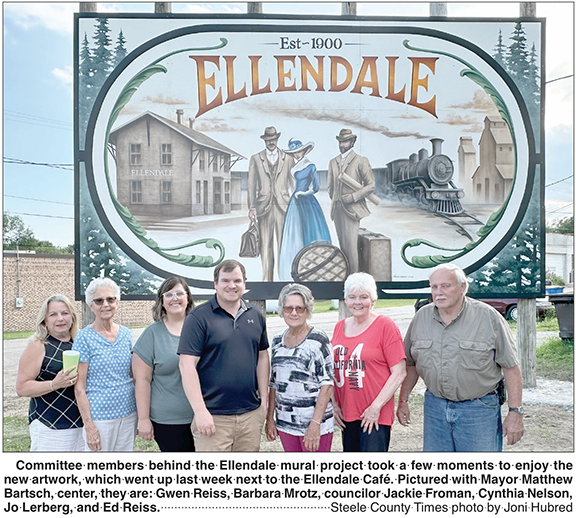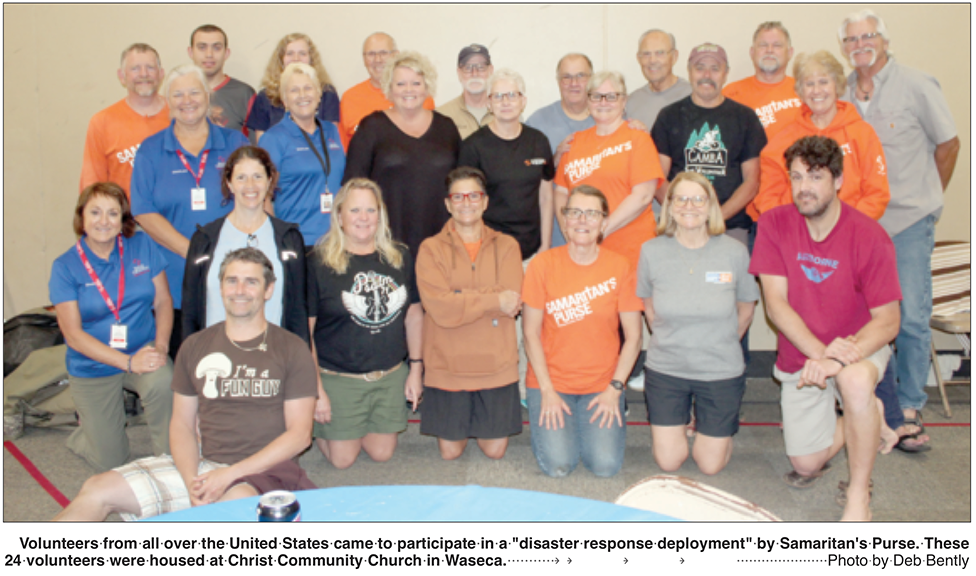Starting small and growing , Matawan Landscape Supply
- Details
- Hits: 4860
By DEB BENTLY
Staff writer
Tyler Baumann, 37, opened Matawan Landscape Supply for a range of reasons. Perhaps lowest on the list is pulling in a large profit margin. “I like helping people,” says Baumann. “I like being outside.
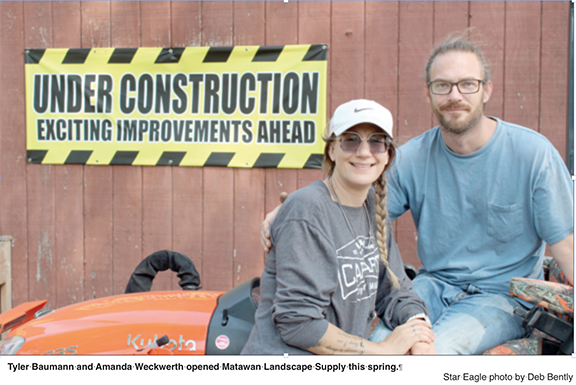 “I love the feeling of gratification when a project turns out,” he says enthusiastically. “It can transform a whole yard.”
“I love the feeling of gratification when a project turns out,” he says enthusiastically. “It can transform a whole yard.”
Residents of Matawan, Baumann and his partner Amanda Weckwerth have been working together all through the past four months to build their landscaping business. Posted on the garage, which is in the process of becoming their showroom, is a huge sign saying “Under Construction.” An additional note enthuses “Exciting improvements ahead.”
Their business is located in the far southeast corner of the county in the small, but once-thriving town of Matawan. Some of the company’s products can be seen displayed on a triangular piece of property along Matawan Avenue which they believe was once a city park. Getting ready to open their business included revitalizing part of the one-acre area, since a former owner had left things in a bit of disarray.
The area now has regained its park-like appearance; mounds of various types of mulches, sands and soil display some of the materials Matawan Landscape Supply has to offer. Galvanized edging for raised garden beds glints in the sun; white cedar planter boxes sport a variety of thriving plants. However, Baumann and Weckwerth explain, there is even more to their business than can be seen from the street.
Their website, www.matawanlandscapesupply.com, lists a variety of landscaping equipment which can be rented at a flat fee for four hours at a time: trailers, tillers, a power broom, a pressure washer, pole saw, and more. Also not visible to a passerby are some of the items kept indoors, including grass seed, fertilizer, erosion control fabric, edging, and the like.
But perhaps the most significant offerings are the experience and goodwill of Baumann and Weckwerth themselves. The two have worked together “flipping” houses and also own some rental property. They explain landscaping has been a significant element of those enterprises, including as many as a dozen projects a year. They say they have already used the contacts, knowledge and experience they have gained in helping some of their customers who have less practice.
“We’ll give people whatever level of help they need,” says Baumann. “We can help them get a good price on the supplies, we can do some of the more labor intensive work and let them finish up, or we can do the whole job for them.
“Our goal is to give them that same level of satisfaction we always feel when the job is done and the project looks good.”
Baumann says he loves the idea of being approached by a customer who has been told his or her project is “impossible.”
“I would just love to prove that wrong,” he comments.
Weckwerth and Baumann mention that, through the spring and first part of the summer, their business has been building only gradually. The year’s odd weather set a number of projects back, and kept Baumann busier than usual with his rental properties.
Still, Baumann says, they have helped quite a number of property owners with a range of projects. He and Weckwerth are happy with their progress so far and intend to keep expanding. Their 24-foot by 32-foot garage, for example, is on its way to becoming a showroom where even more products will be displayed.
“It’s a long-term goal to be more full service,” Baumann speculates. “We would like to have seasonal employees who go out and do these projects all over the area.”
By this time of the year, Baumann says, many people have either completed their intended projects or the end-of-summer temperatures have led them to postpone them to next year. Grass seeding or fertilizing to take care of bare spots will be best left to fall, since grass does not propagate well in the heat.
“We’re here for people who still have projects,” he assures. “And we’ll have even more to offer next spring.”
“I’m excited,” observes Weckwerth. “We’re open. We’re helping people, and we have an even bigger future ahead.”
At this time, Matawan Landscape Supply is open from 11 a.m. to 7 p.m. on Thursdays, Fridays, and Saturdays, and from 10 a.m. to 2 p.m. on Sundays. Baumann is also open to receiving phone calls both during business hours and at other reasonable times: available numbers are 507-340-1247 or 507-200-4674. He also encourages folks to visit the matawanlandscapingsupply.com website to find out more.
Samaritan's Purse volunteers working to restore home
- Details
- Hits: 4695
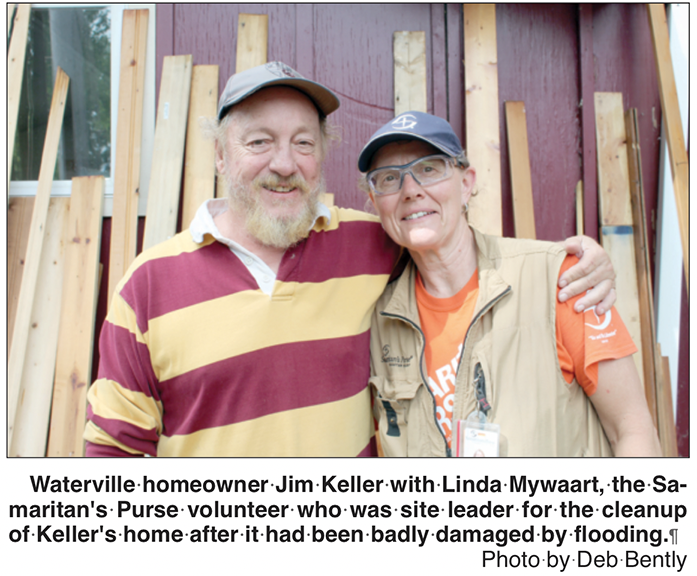 By DEB BENTLY
By DEB BENTLY
Staff writer
Waterville resident Jim Keller says he has gone through the five stages of grief over the past month. Keller’s home of 25 years sits on the shore of Lake Tetonka. A favorite feature of the simple structure is a sturdy deck that looks directly out over the lake.
In all the time he, his wife Teresa, and his now adult sons James and Erik have occupied the structure, there had been water in the crawl space underneath a few times, but never in the house.
So when Lake Tetonka began to rise in mid-June, he says he was able to remain in the stage of denial for a time.
“I told myself, ‘It won’t get that high,’” he remembers of those first few days.
As the water continued to rise, he and his family put sandbags around the house. “The water rose higher, so we got more sandbags. We just kept stacking them,” he remembers. Despite their hard work though, water filled the crawlspace and then actually began flowing up into the house through the air vents. “It was coming from everywhere, and we knew there was nothing we could do,” he describes.
“That’s when it became a rescue mission. We had lost the battle, so it was time to start saving what we could.” Family and friends used concrete blocks to lift the stove, refrigerator and beds above floor level. When it became evident the blocks weren’t tall enough, “It was chairs,” Keller remembers.
“Somewhere in there, I got to the ‘anger’ phase. God wasn’t very high on my list about then.”
The bargaining and depression phases were likely spread out across the four or so days the family had no access to their home and then the first time they were able to return.
At its height, Keller estimates, the water level reached about 7 feet above where it had been when spring began. Water had risen at least 18 inches inside the home, soaking carpets and drywall. The stench of spoil and mold were pervasive. Furnishings, decorations and photographs that had been part of the family’s life for decades were ruined.
“It looked hopeless,” Keller describes.
All through the disaster, LeSueur County and area benevolent organizations had been providing services, including sandbags and sand, emergency shelters, meals and medical attention. As the water began to recede, area homeowners were invited to meetings where they were informed of further disaster assistance services.
Keller and his family attended, learning for the first time of “Samaritan’s Purse,” which is described online as an “evangelical Christian humanitarian aid organization.” The group would be coming to the area, and would be providing help free of charge.
“We got on a list,” says Keller with surprising good cheer. “And one day these folks showed up.”
On Wednesday, July 10, Samaritan’s Purse volunteers were in their third day of working at Keller’s house. A box truck with storage for tools and equipment stands out front. With the building almost cleared, most workers have cycled on to other sites, but three remain.
Inside, Dave Sheevel, 81, a Texan, is pulling plywood off one wall while Jeff Streich, a Janesville area resident and member of Waseca’s Christ Community Church, is doing the same in the next room.
Around them, only bare studs–with even the nails pulled out–show where one room ended and the next began.
As he continues working, Sheevel tells of having flown up from Texas and rented a car to use while in Minnesota, all at his own expense. He says he began volunteering with Samaritan’s Purse in January of 2023 and is on his ninth “deployment.” Through the organization, he has helped victims of fire, hurricane, tornado, and now flood.
“It’s very rewarding,” he says as he tugs on plywood. “I feel blessed I still have the health and the means to be here.
“I feel blessed to help.”
Streich is volunteering for the first time. He says a call for help was issued through his church. “I had some free time, so I thought I’d come over,” he comments.
Out by the box truck, Canadian Linda Mywaart gives a quick summary of the steps followed during a “mud out,” the clearing of a structure which has been soaked and filled with debris by flooding.
“Our chief goal is to give the homeowners hope,” she begins. “When they return after there’s been a flood, the space gives an impression of being completely ruined. It looks like such a big mess that they’ll never be able to get it cleaned up.”
She notes the smell, the quick onset of mold, and the debris left behind as the water recedes all work together to reinforce the impression.
The first step of the cleanup process, Mywaart explains, is that a designated organization “assessor” enters the structure to determine the extent of the damage and the steps needed to make it “reconstruction ready.”
Volunteers follow through on the plan: Samaritan’s Purse supplies tools, equipment, safety gear and support such as water, snacks and group meals.
“We remove the ruined materials and expose the surfaces that have been soaked by water, so they can dry,” Mywaart explains. “Once that’s done, we back our way out of the house, spraying down all the surfaces with a mold treatment as we go.”
Mywaart has been trained as a “site leader” for Samaritan’s Purse Canada since 2019. She tells of having been deployed numerous times to disasters, including hurricanes, tornadoes, fires and flood. This is the first time she has volunteered outside Canada, however. She reveals that her husband, a trained heavy equipment operator, is in Greenfield, Iowa, helping at a location affected by tornadoes.
She admits the work is “hard, hot, and heavy,” but, “It’s also heart work,” she says. “We are a group of Christians who believe we need to live our faith with our hands and feet.
“My husband and I feel we are both extremely blessed to have the faith, health, and means to volunteer,” says Mywaart. “We also have the support of a congregation back home who are praying for us.”
Groskreutz reunion draws more than 100
- Details
- Hits: 3704
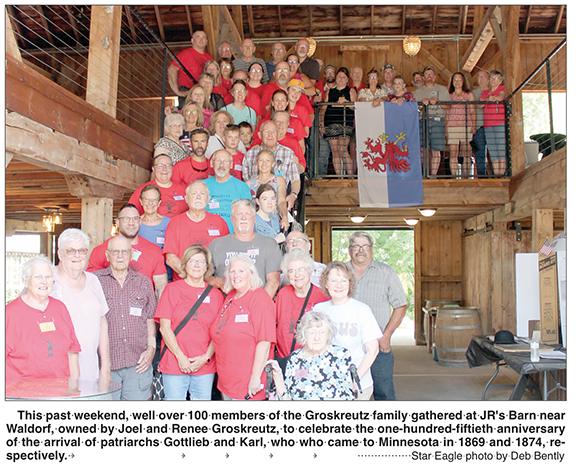 By DEB BENTLY
By DEB BENTLY
Staff Writer
“We’re all strangers,” admits Jeff Groskreutz. “But we’re still family.”
Jeff, 69, and his wife Linda lived in Pemberton for 36 years before moving to a home on Lake Washington this summer. “Anyone who knows me,” he comments, “knows I love a good story.” It seems there’s no better place to find them than by studying genealogy.
Jeff has put together a self-published book well over 600 pages long which lists about 11 generations of the Groskreutz family. The back 90 pages are an index of 4,100 names which appear in the book. “What makes my book different from most genealogy books,” he observes, “is that I put in a lot of detail. If I know you raised a 300-pound pumpkin that won a prize at a local contest, I’ll put it in.”
Thanks to Jeff’s research, the Groskreutz family is aware of connections all across the country. Using that collected information, they shared the news that 2024 marks year 150 since Groskreutz ancestors took up residence in Minnesota.
Two brothers, Karl and Gottlieb, arrived shortly after the end of the Civil War, taking up residence on farmland in the area of Waseca County’s Matawan in 1869 and 1874. Even today, family members point out, there is a two-mile stretch of road where all the homesteads belong to a Groskreutz.
“The story, right or wrong,” relates Jeff, “Is that they came for two main reasons. One is that, since they weren’t the oldest sons, they were not in line to inherit any land from their father back in Germany. Young men were also at risk of being drafted as soldiers in the regional wars taking place in Europe at the time.
“Also, once Gottlieb was here, he wrote letters to his younger brother Karl. He told him there was land available, and the grass was so thick and tall it was up to the cow’s knees.
“Gottlieb even paid the cost to bring Karl and his family across the ocean and to Minnesota.”
The stories grow from there.

